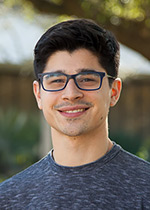Award Will Support Conference Participation
Andrei Gasic, a second-year physics Ph.D. student at the University of Houston, was awarded the Carl Storm Underrepresented Minority (CSURM) Fellowship. This award, for the amount of $600, supported Gasic’s participation in the 2016 Protein Folding Dynamics Gordon Research Conference in Galveston, Texas, January 10-15.

Andrei Gasic is a physics Ph.D student.Gordon Research Conferences are hosted worldwide and cover a wide variety of topics,
with a mission of providing “an international forum for the presentation and discussion
of frontier research in the biological, chemical, and physical sciences, and their
related technologies.”
During the conference, Gasic presented a research poster titled "Pressure induces folding intermediate state of phosphoglycerate kinase in coarse-grained molecular simulation.” His research, directed by Margaret Cheung, associate professor of physics in the College of Natural Sciences and Mathematics, involves simulating and developing a theory behind protein communication over long distances in the cell.
Much of our current understanding about how proteins interact is derived from studies conducted in test tubes. However, cellular conditions are much more crowded than in the test tube environment, which affects how proteins interact and function.
“When talking about macromolecules like proteins, short-range interactions consist of bonding, hydrophobic/hydrophilic interactions, or other interactions in which the two interacting objects are touching or almost touching,” Gasic said.
How proteins communicate over longer distance in cellular conditions is still largely unknown. Gasic’s research is directed toward understanding the types of mechanisms required for long-range protein interactions in the complex environment of the cell.
“We are interested in how hydrodynamics interactions, where small vibrations or disturbances are transferred by the surrounding water molecules, affect protein interactions over a longer range,” Gasic said. “However, inside the cell, the median is not just a pool of water, but is a highly crowded and heterogeneous environment. In the future, I hope to understand long-distance protein interactions inside the cell.”
- Rachel Fairbank, College of Natural Sciences and Mathematics